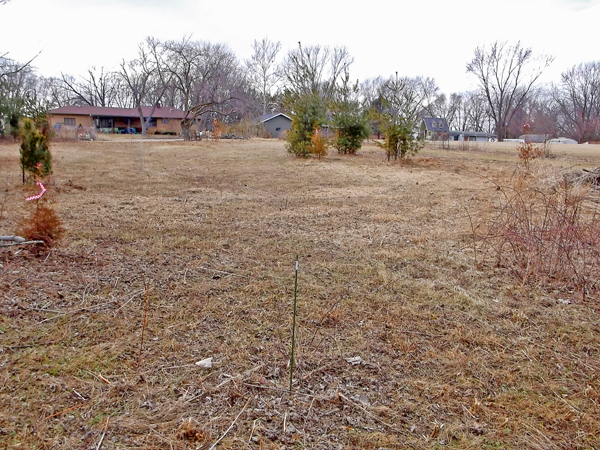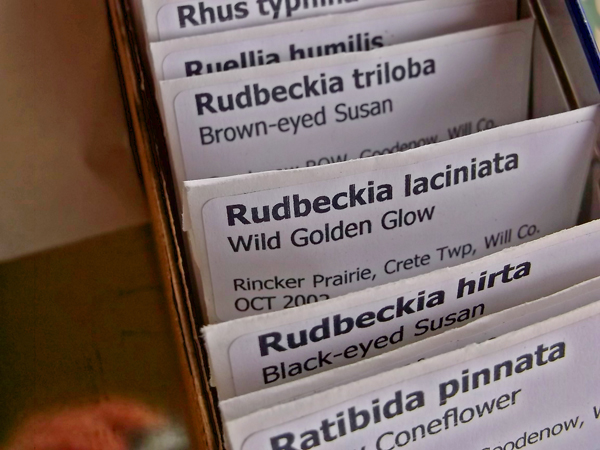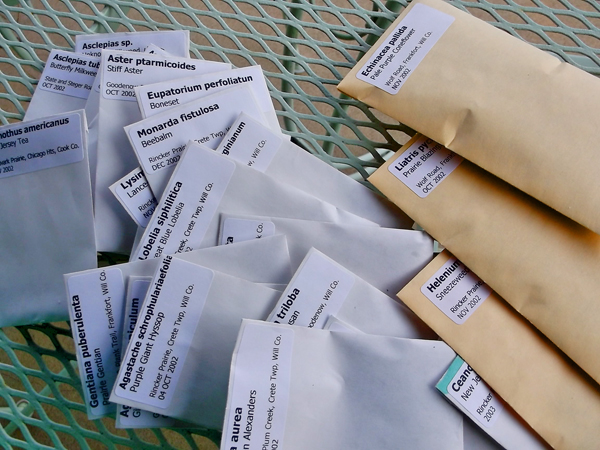
Tools of the trade, pruning shears and a steel garden rake
The Prairie Garden
With rake and shears in hand, along with a pair of leather gloves and a plastic tarp, I was ready to tackle some spring clean-up chores around the yard. First on the list was the front yard prairie garden. For most of the winter, it was buried under a few feet of snow:
So by the time April came around the garden was looking more than ready for a trim:
The prairie garden is a mixture of colorful, sun loving, Midwest natives, including Blue Baptisia, Orange Milkweed, Paradox Coneflower, Pasque Flower, and Purple Milkweed, along with Little Bluestem, Big Bluestem, and Prairie Dropseed grasses. The dried remnants generally look interesting throughout the winter, but this winter, the snow came early, and stayed late. To begin the clean-up I laid out the tarp and started raking the loose debris on to the tarp. The grasses held tight, so they were cut back with a pruning shears.
All of this debris was hauled back to the wire bins for conversion to compost:
After about an hours worth of work, the front garden is ready for spring:
The garden doesn’t look like much right after its trim, but in another week, or so, the Pasque Flower (Pulsatilla vulgaris, or Anemone pulsatilla, or A. patens) should be in bloom. I purchased my Pasque Flower at a garden center, so I’m not sure if its parentage is North American or Eastern European, but its a great early bloomer, no problems, and interesting fluffy seed heads in late May and June. The native Midwestern form and the European form look similar to my eyes.
The prairie garden is quite lush in June, as shown in the photo below:
The Orange Milkweed (Asclepias tuberosa) and the Pale Purple Coneflower (Echinacea pallida) really pop, against the blue-green leaves of the Little Bluestem grass (Schizachyrium scoparium, or Andropogon scoparium.)
The Meadow
In the backyard a meadow of Midwestern prairie plants commands the attention of the viewer. The meadow is always alive with the activities of birds and insects, including butterflies, dragonflies, and others. The meadow gets mowed once a year, towards the end of March. This keeps the brush, such as blackberries, Silver Maples, Grey Viburnums, and buckthorn from taking over, that and hand application of herbicide, as needed. Normally, I have used a heavy duty brush cutter to do the job, but that wasn’t wanting to start this year, so my 15hp Craftsman lawn tractor was called into service. It did a fine job as well.
The result is a clean slate, not only is the brush kept in check (not killed mind you – that’s where the herbicide comes in later, or before, depending how you look at it) but the smaller plants are not competing with last years growth. There is nothing that says spring more than a green swath of Pennsylvania Sedge (Carex pensylvanica) with violets blooming among its bright green grass-like leaves.
The meadow is awash with color during the growing season, always something new throughout the year, and changing, year to year.
I’m always adding new planting to my gardens, and that includes the meadow. This year, I decided to spread some seed that I had stored in my refrigerator – collected from unmanaged wild areas, usually along railroad easements or forgotten urban parcels of land with prairie remnants. The seed was cleaned and placed in paper envelopes, labeled with date of collection, location, and species name. At the time that these seeds were collected, I was propagating plants to sell. I no longer do that, so I went through the seed collection, and chose plants that I wanted in the meadow, the others were planted near my parent’s property in the country.

The packets were sealed with rubber cement so that they could be resealed over and over after opening
For the most part, prairie seeds need to go through a cold moist period before they will sprout, or at least more of the seeds will sprout, after going through this “stratification” process. This is the reason prairies are normally seeded in the fall or very early spring. Most seeds need 30 to 90 day of cold, moist, stratification. William Cullina has written an excellent propagation book called Growing and Propagating Wildflowers that explains the treatment that each species needs for propagation. Hopefully the seeds planted this past March will sprout this spring, and provide added interest in the meadow for years to come.
The Oak Woods
Years ago, In my parent’s front yard I planted a small garden with a mix of woodland, savanna, and prairie plants. Over time, the plants have moved around and spread to form a larger garden. To help maintain the garden’s integrity and clean out last year’s growth, I usually do a spring burn. The garden is surrounded on two sides by lawn and by asphalt on the other sides. It takes all of about 15 minutes to complete the burn. This year, I was kept company by a Coopers Hawk nesting in a nearby Oak. I didn’t get a photo of the bird, but the nest can be seen in the center of the photo below:
In the summer the garden is wild mix of many species, coexisting in some form of harmony. Below, the this west facing garden is seen in early June, with the flowers of Tradescantia showing off their electric blue color.
In the town of Crete, Illinois, where I drop off my recyclables, the Lions Club has a nice display of the same Tradescatia (T. ohiensis) in front of its sign, right along with some red Knock-Out Roses and yellow Sundrops – a bright show of primary colors.
Out back the White and Red Oak woodland was getting invaded by brambles, including multiflora rose, gooseberry, and blackberry. To knock these back, this area was burned as well, mimicking what naturally occurred over the last several thousand years – burns help keep the woods open and healthy. Soon, the spring woodland flowers (spring ephemerals) will be up. Red Trillium, Jacob’s Ladder, Hepatica, Bishop’s Cap, Solomon’s Seal will all be showing growth very soon and the woodland floor will a carpet of green.

The six inch flames burn into the direction of the wind, and towards the lawn in this case. The Blackberry cames can be seen amongst the flames here.





























